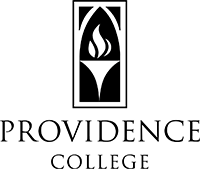February 23, 2017
LEGACY IN FRIARTOWN: Bryan Donovan ’20 and Drew Ford ’20 share their unique perspective on the 1986-87 Friars
By Stasia Walmsley
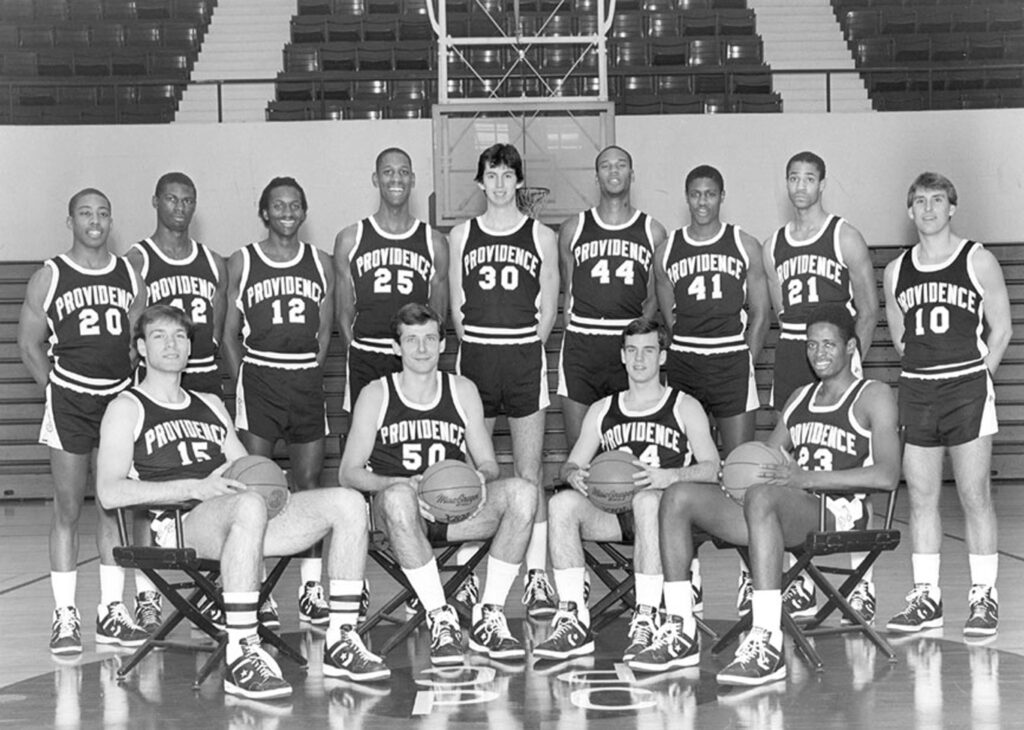
What if the smallest school in the BIG EAST Conference — from the smallest state in the country — made it to college basketball’s biggest stage?
In 1987, Coach Rick Pitino led Billy Donovan ’87, Ryan Ford ’89, and the Providence College Friars to the Final Four. Thirty years later, Donovan’s son, Bryan, and Ford’s son, Drew, are first-year students and members of the Class of 2020 at PC. They’re both part of the men’s basketball program — Bryan as a guard, and Drew as manager. Their mothers are PC alumni as well — Christine D’Auria Donovan ’86 and Pamela Ford ’90.
Below, Bryan and Drew offer a singular perspective on basketball, legacy, and the Friar family.
What are your first memories of basketball?
Bryan: Watching my brother play when I was growing up inspired and fueled me. When I was 3 or 4 years old, he was 8. He really was the biggest driver, because I wanted to be like him.
Drew: In our basement we had this big, open area, and we put up a Fisher Price hoop. We’d use masking tape to tape off a court. Me, and my older sister and brother, we’d go down and play for hours with this tiny basketball. And the funniest thing is that my dad, when he saw us make a right-handed layup, he’d always make us make a left-handed layup, too. “Now do it with your left-hand, Andrew,” he’d say.
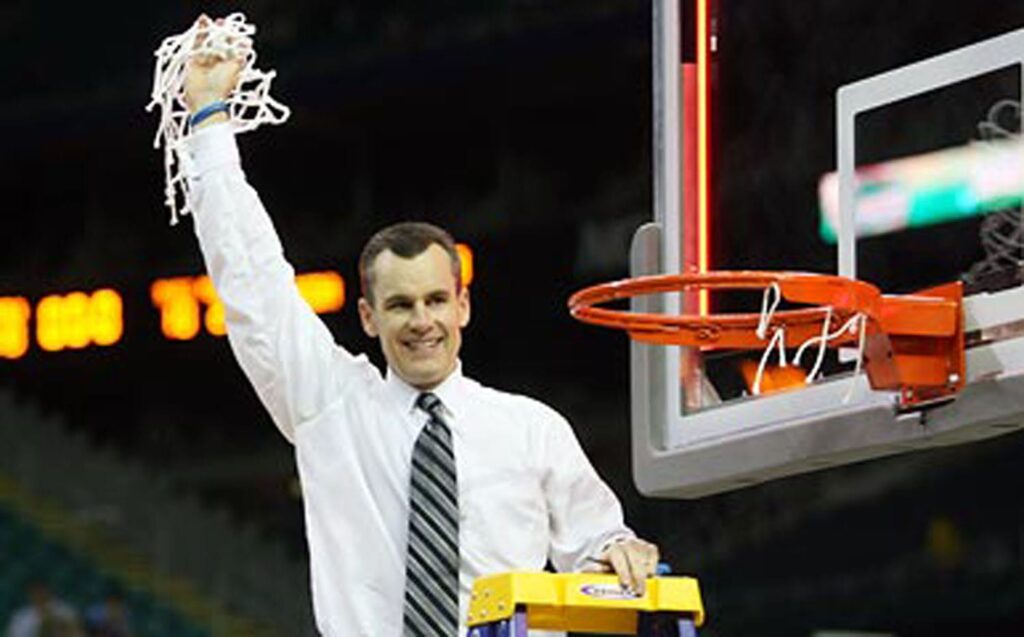
When do you first remember hearing about Providence College and the experiences that your fathers had going to the Final Four?
Drew: I always kind of just knew it. But as I got older I understood how hard it was to get to the Final Four, especially for a team like them that wasn’t supposed to go that far. At a certain age it was like, wow. That is actually pretty cool. My dad went to the Final Four!
Bryan: My grandpa has about 12 to 15 games [on tape], and when I was in fifth or sixth grade I watched them. And I remember being like … my jaw would drop. I don’t want to sound like I’m bragging, but my dad was pretty good. Actually seeing for myself, I was really amazed. He’s humble though. He doesn’t really like talking about it.
Drew: That’s what happens when you are a star player, but my dad loves to talk about it. (laughs)
Bryan: In my old house we had a weight room with all these posters. My dad used to coach at UK (the University of Kentucky; he is currently head coach the NBA’s Oklahoma City Thunder), so we had a poster from there. But then we had this big Billy the Kid poster. It was my dad with a sheriff’s hat on. It was like a cartoon. I remember seeing it and asking him about it. And then we read the story about Billy the Kid, who was some kind of Wild West cowboy who never missed. So I caught on at a pretty young age.
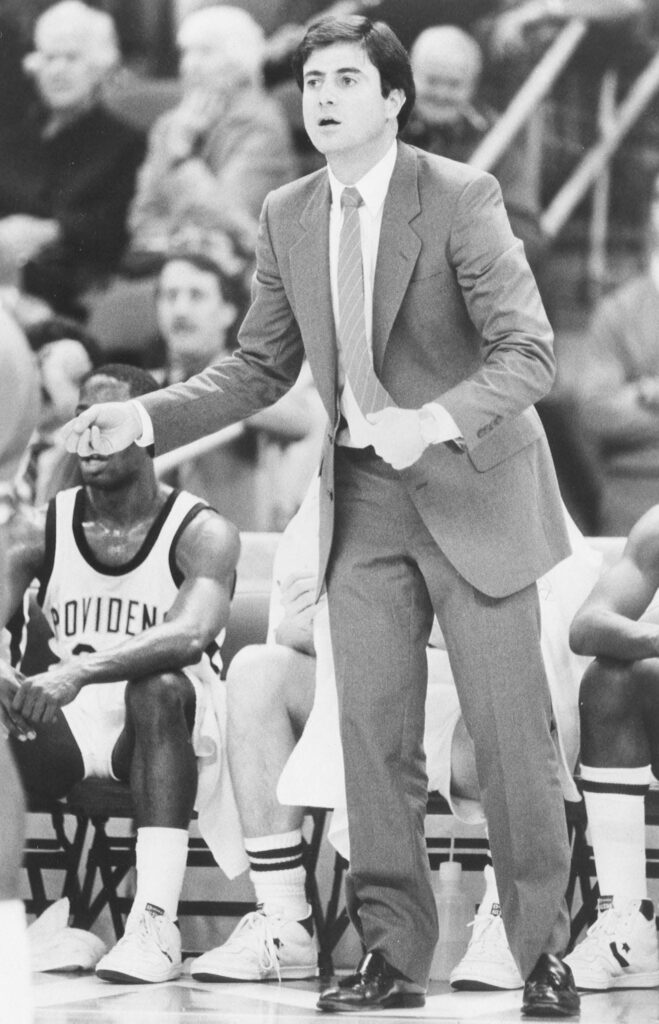
Do you think the work ethic instilled by Coach Pitino during the ’87 season has had an impact on the way your fathers expect you to approach basketball and life?
Bryan: Yes. One hundred percent. And Coach Cooley (current coach Ed Cooley) too. He preaches that you have to do more. So if that’s getting on the bike or getting up extra shots in order to stand out, you have to do something more than what every other player in the country is doing.
Drew: I know there are rule changes now, but my dad told me that they practiced before breakfast. They practiced in between classes. And then the “real” two-to-three-hour practice was at night. Then they’d all be expected to stay after and get extra shots. My dad always says that he learned more about life by playing basketball than he ever did in any class he ever took. He learned it in basketball, but he uses the work ethic in everything he does. It’s become a life lesson for him, and for me.
The three-point shot was instituted before the 1986-87 season and became a big part of Pitino’s game plan. He called it, “The great equalizer in basketball.” Do you agree?
Bryan: My dad would say, “If you can shoot the ball, no matter how big you are, there is always a spot for you on the court.” And adding the three-point shot back then only made it more significant.
Drew: After practice, my dad said they used to take 100 shots at a time. And by the time they left the court they would’ve put up maybe 800 or 900 shots. But they would only count their misses, because they made so many — like 90 out of 100. Or that might’ve been Bryan’s dad. My dad, maybe 80 out of 100 (laughs). And if you watched the games, you saw how good Billy was at it.
How does it feel walking around campus and playing ball where your dads did the same thing?
Drew: I was most aware of it during orientation when my parents were here and my grandmother came. It was funny, because we were walking back to lower campus, and I was walking a certain way, and my mom was walking a different way. My dad said, “This is the way we used to go.” And I was clearly not going to win that battle. So now, when I’m walking, I always go their way — it’s a little bit slower, but I always do it.
Bryan: We are here with the team now, with Coach Cooley, and it’s pretty hard to think about anything that happened back then. But there are some flashes though, when I think — oh, my dad played here 30 years ago.
Why did you want to come to PC?
Drew: I always wanted to go to Florida and work with Bryan’s dad. [Billy Donovan coached at the University of Florida from 1996-2015.] When he left, I didn’t know what to do. Then Coach Cooley said, “Why don’t you come work with me.” PC became the only school I applied to. My parents would always say they wanted one of their three kids to come here. And we always said, “no way, we’re not going to PC. It’s weird to go to your parents’ school.” But now, here I am.
Bryan: [I came] mostly because of Coach Cooley. I wanted to be part of a basketball program that was on the rise. And I wanted to be a part of the culture he was building here. My dad told me to enjoy it, but to also stay true to who I am. Meet great people, but still be true to who I am as a person.
What’s it like to be part of the Friar family?
Bryan: You can feel a sense of unity. It’s hard to describe, but you can definitely feel that there is something here. It feels like the whole school rallies behind the sports teams. And not just basketball. The whole school, the whole community has the team’s back.
Drew: I’ve seen the family aspect with the coaches. I’m the manager, so there’s no need to reach out to me to see how my classes are or how I’m doing. But they all do it. They’ll stop and talk, see how my day is going. If Coach Cooley is going down to Alumni [Hall cafeteria] to eat, he checks in with everyone in the office to see if they want to go with him. It’s very much a family atmosphere.
What do you like most about PC?
Bryan: For me, it’s being at practice surrounded by D-I (Division I) athletes. It’s fun and a good challenge.
Drew: I agree. I’m more excited than anything to be a part of the team. I’ve been waiting for this for two years now. When we played at Ohio State, it’s the first time we were both on a team that was on TV. So it was kind of weird watching the people that you interact with every day. My whole life I spent watching people I don’t know. But now you’re like: Wait, I know exactly what he’s thinking right now. When Coach Cooley goes nuts, I know if somebody has messed up. It’s a different feeling for sure — it’s cool.
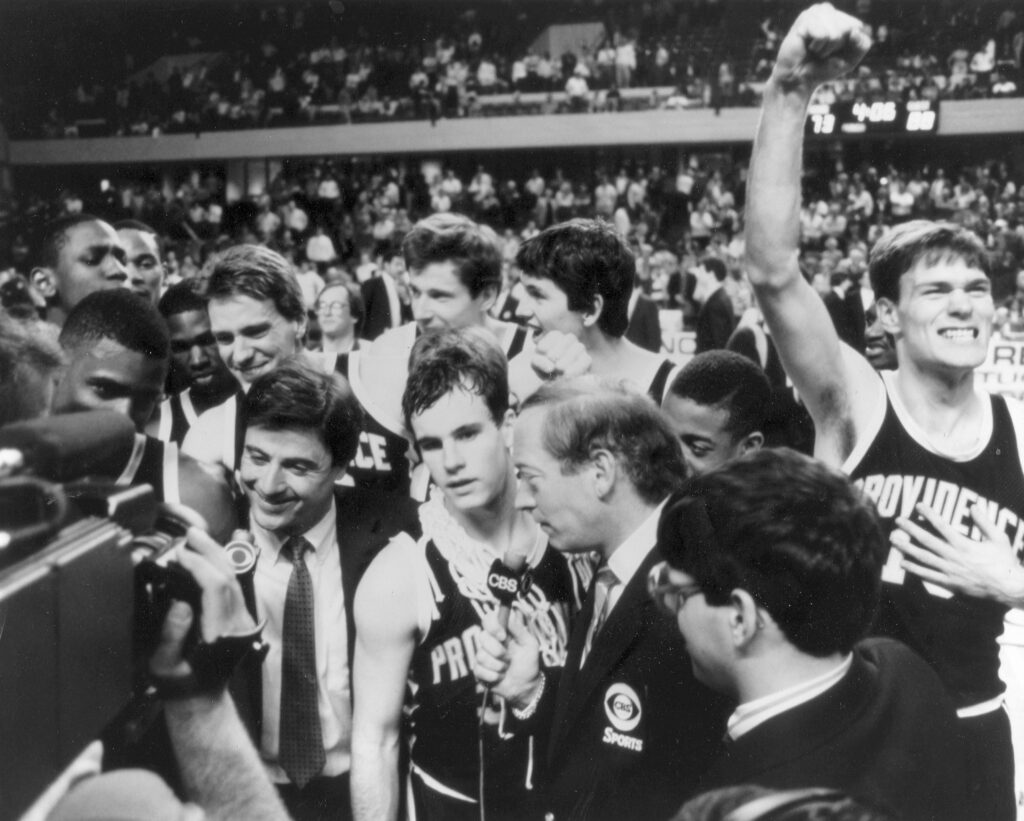
1987 Final Four Friars
By Mike Scandura
This article appeared in the program book for the 20th Anniversary Celebration of the 1986-87 Providence College Men’s Basketball NCAA Final Four Friars on May 12, 2007, at the Rhode Island Convention Center.
The way Herb Sendek sees it, the 1986-87 season wasn’t about the Providence College Friars “proving anybody wrong.”
“The young men we had on that basketball team had unparalleled work ethic,” said Sendek, the Arizona State head coach, who was an assistant to coach Rick Pitino. “They worked so incredibly hard that it was wonderful to see them rewarded for their incredible efforts.”
“It was a group of guys doing extraordinary things.”
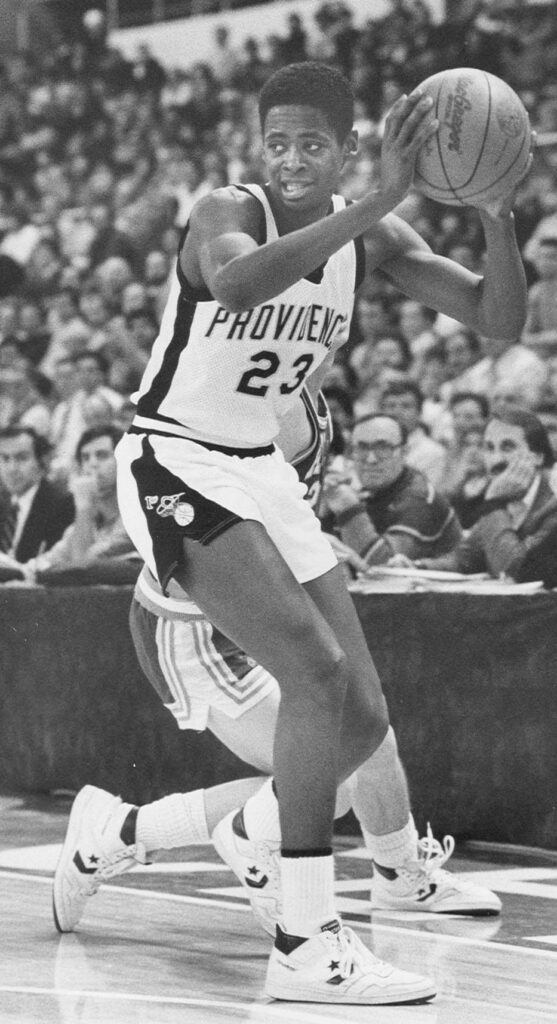
How true, because the nucleus of the 1986-87 Final Four team was comprised of players, who two years prior, were 11-20 and seemingly headed nowhere. But for that one magical season, the Friars stood the basketball world on its collective ear. Besides changing how the game would be played, the Friars provided one of the best college basketball stories ever.
The trick in analyzing that season is determining where to start.
Billy Donovan, who’s enjoyed unparalleled success at the University of Florida, felt the key point was a pre-season exhibition game against Russia. (“We knew how good they were,” Donovan said of a national team that essentially consisted of pros. “That game gave us confidence.”)
Sendek felt the 82-79 victory over Georgetown at the Providence Civic Center, where Pop Lewis lit up the Hoyas from three-point range, was a “particular turning point.”
BIG EAST Commissioner Mike Tranghese (who was the assistant commissioner at the time), felt the 88-73 win over Georgetown in the NCAA Elite Eight, a game where Pitino eschewed the three-point shot in favor of going inside, was the “most stunning game of the season.”
There was also a 96-78 win at previously-undefeated Villanova where a transfer named Delray Brooks, who was struggling with his outside shooting, torched the Wildcats for a career-high 34 points — after receiving some “advice” from one-time Friar All-American Joe Hassett. (Hassett suggested that Brooks, in pre-game warmups, commence taking shots from inside the arc and gradually step back and increase the distance to the basket in order to develop a “feel.”)
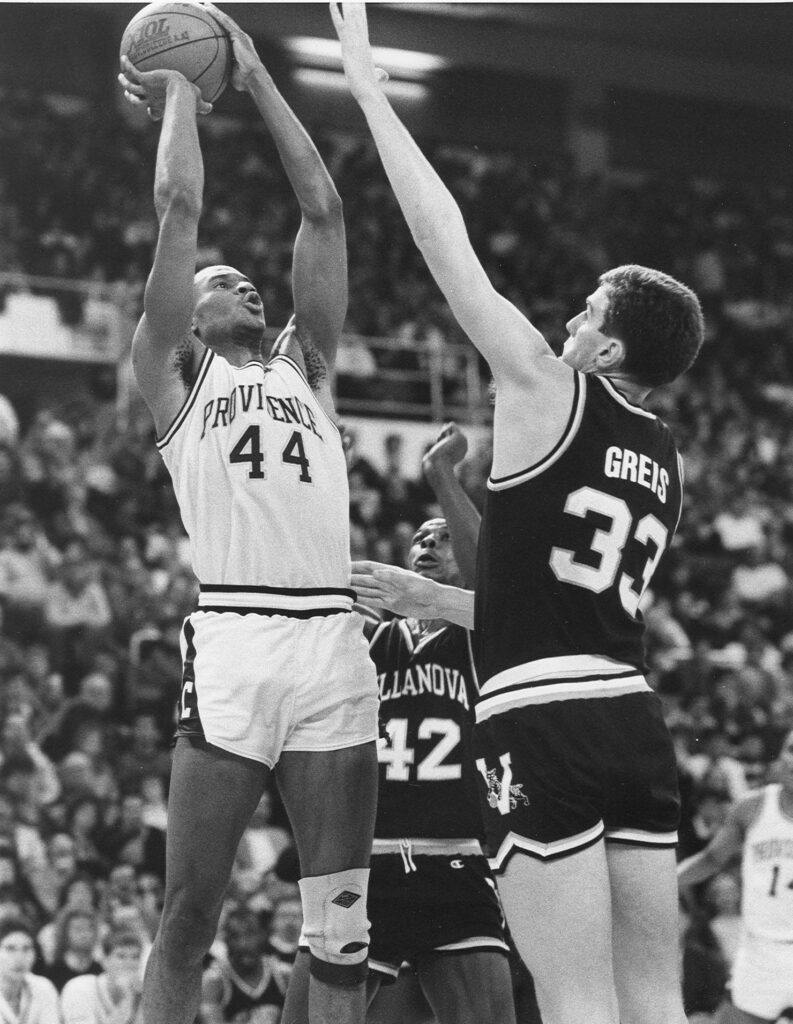
And of course, there was the 90-87 overtime victory against Austin Peay in the second round of the NCAA Tournament. PC literally snatched victory from the jaws of defeat, overcoming a 10-point deficit in the last 5:52 — and catching one of the all-time breaks when the Governors’ Bob Thomas bricked the front end of a one-and-one with two seconds left in regulation (following consecutive timeouts called by Pitino), a one-and-one that, if he made even the first shot, quite likely would’ve sent the Friars packing.
The three-point shot is as good a place as any to start.
When the NCAA implemented that shot prior to the 1986-87 season, most coaches invariably went kicking and screaming into their gyms.
Not Pitino. He embraced it like a winning lottery ticket (or maybe in Rick’s case, a Kentucky Derby winner).
“There wasn’t a coach in the country who understood the three-point shot better than coach Pitino because of his time in the NBA,” said Donovan, who’s fresh off a second consecutive national championship at Florida.
“Coaches historically have fought changes to the game, but Rick saw what it could do,” said Tranghese. “Now, 20 years later, there isn’t anybody who doesn’t use it.”
PC averaged 19.6 three-pointers a game that season and made an average of 8.2, for 42.1 percent. Conversely, the Division I average for three-pointers a game that season was 9.2 attempted and 3.5 made.
The win over Georgetown at the Civic Center was a microcosm of that season.
Lewis buried a trio of treys. The first tied the score with 2:02 left. The second gave PC a 79-77 lead with 44 ticks of the clock remaining. The third, with two seconds left, sank the Hoyas, 82-79.
“The last shot was just like practice,” said Lewis. “Bill would drive and if he couldn’t get a shot, he would kick it to the corner. One other shot was similar … kick to the corner or foul line extended. Another shot was top of the key.
“I wouldn’t really say they were designed plays because that’s the way we played.”
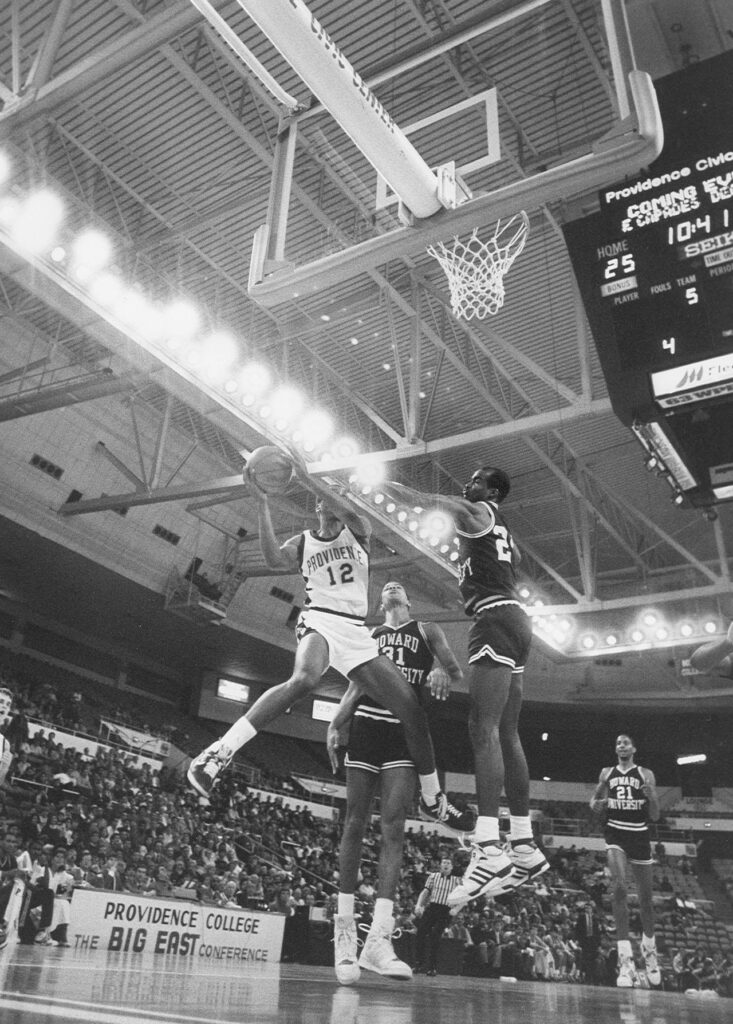
As proficient as the Friars were at making three-point shots, they were equally as adept at stopping opponents from emulating them.
“What doesn’t get talked about is how well we defended the three-point shot,” said Donovan. “We stopped the three-point shot and were among the best teams in the (BIG EAST) conference at doing so.”
Indeed. PC held opponents to 31.2 percent shooting (109-for-349) from three-point range.
“We were so far ahead of the competition with the power of that line, on offense and defense,” said Sendek. “It gave us tremendous advantage and clearly was a determining factor in our going so far.”
Perhaps the “anti-PC” game was the 88-73 romp over Georgetown which propelled the Friars to the Final Four in New Orleans.
Instead of relying on Donovan, Brooks, and Lewis to shoot holes through the Hoyas, Pitino largely put the three-point shot on a shelf — because Pitino thought the only way to beat Georgetown (who throttled the Friars, 84-66, in the BIG EAST Tournament) was to pound the ball inside and get the Hoyas in foul trouble.
After burying 14-of-22 three-point shots in a 103-82 Sweet 16 romp over Alabama, PC only was 5-for-9 from beyond the arc against Georgetown. Donovan and Brooks each were 0-for-1 from three-point range in that game. But Donovan sank 16-of-18 free throws (Georgetown star Reggie Williams hacked Donovan on more than one occasion); center Steve Wright scored all of his 12 points in the first half, replete with seven blocks; and forward Dave Kipfer set the tone by powering through the lane for the game’s first basket.
“A lot of times for a team there will be a sense of sacrifice,” said Donovan. “I think in that game the biggest thing I remember is coach Pitino saying we have to play differently than we were used to. He said if you really want to win this is what you have to do. He said to Delray and me, ‘If you shoot the ball, we can’t win.’ We had great confidence in the staff in that we knew what they were doing was the right thing. We all said it wasn’t about ‘me.’ I wanted to win more than score points and would do whatever I had to do.”
Oh, yes. Because the Georgetown game was played barely 48 hours after the win over Alabama (Donovan and Brooks combined for 49 points in that game), Pitino only had two opportunities to implement his new strategy: during a less-than-two-hour practice the day between games and during the morning walk-through before again going up against the Hoyas.
Moreover, there weren’t any lingering effects from PC’s loss to Georgetown in the BIG EAST Tournament, a game that Tranghese felt the Friars “…got physically abused and handled pretty easily.”
“We had a meeting the day after the Georgetown game,” recalled Lewis. “After it was over we knew we couldn’t get it back so we focused our efforts on the tournament.”
“Looking back, I remember being on coach’s TV show and he asked, ‘What are our goals?’ One was to win the BIG EAST, and the other was to go to the Final Four. All the seniors said the same thing. Going back to the Georgetown game, that was one goal we didn’t reach. So, we focused our efforts on reaching our second goal.”
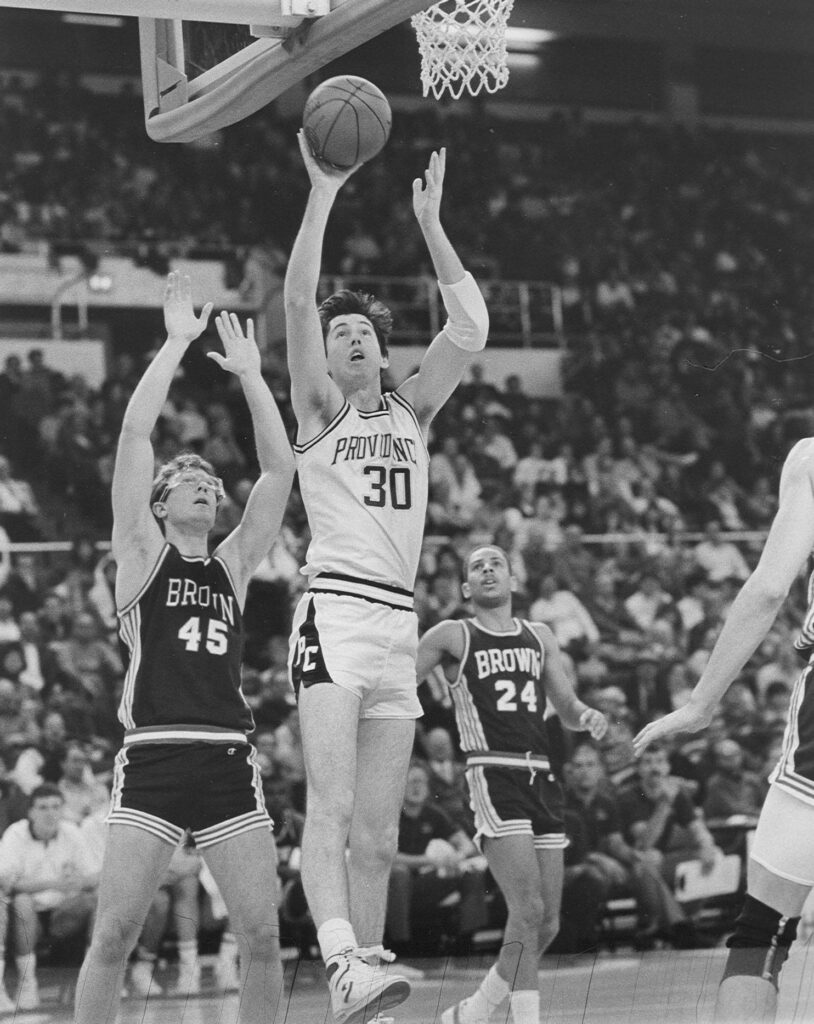
Three-point shot aside, the Friars might not have come within sniffing distance of any goal were it not for their full-court, pressure defense — which prompted assistant coach Gordie Chiesa to name it the “mother-in-law” defense.
When the final stats were totaled, PC had forced opponents into an average of 20 turnovers per game. And that doesn’t necessarily reflect all the forced or rushed shots.
“I remember coach saying UNLV was the Runnin’ Rebels, and people thought they were the hardest-working team in the country,” said Lewis. “We wanted to out-work them. Believe me, the games were a lot more fun. Our practices were a war.”
“We shot the three-point shot and pressed for 40 minutes. We ran pressing drills … 3-on-3s, 4-on-4s, sometimes 5-on-4s where we had to stop five guys. There was constant running, and everything was done at game speed. Some of us, Delray, Billy and myself, never came off the floor in practice.”
“Sometimes we made mistakes,” continued Lewis, “and (coach) sent us to the track.”
And it wasn’t to take a rest.
“Rick had the ability to take kids who thought they were in great shape, break them down, and convince them they weren’t in great shape,” said Tranghese. “Then, he built them back up and got them in the shape they needed to be in to play that defense. It was remarkable.”
A lot of what Pitino accomplished was within the context of individual instruction at Alumni Hall.
“There was no 20-hour rule (which, ironically, the NCAA eventually established after PC’s Final Four season),” said Donovan. “No team invested as much time as we did. Coach Pitino had us in the gym a lot, and you saw us get better as a group.”
The Friars also got slimmer, as Sendek was quick to note.
“The truth of the matter is as Billy was losing 25 pounds, Jacek Duda was losing 40 pounds,” he said. “Dave Kipfer was making the transition from a guy who split time between playing ice hockey and basketball to being the fiercest power forward in the BIG EAST. What happened wasn’t a fluke.”
“What I recall with amazement is the work ethic…the complete and total dedication that the men on that team had and how hard they played,” said Sendek. “Eventually, that dedication spawned into a tremendous brotherhood and ability to play together. It started with hard work and spawned into a very tight-knit group who knew what the other guy was going to do on the court.”
In retrospect, what PC did that season defied all logic considering the team wasn’t stacked with potential All-Americans.
“The best player on that team was Billy,” said Tranghese. “After that, you had some nice college players. The whole team was what you evaluated. What Rick was able to do, and by taking advantage of the rule changes, was what led them to the Final Four.”
The “nice college players” Tranghese referred to included, besides, Brooks, Lewis and Kipfer, Duda, a big center who immigrated from Poland; the Wrights; Marty Conlon, a freshman forward who would go on to play several years in the NBA; Carlton Screen, Donovan’s successor at point guard; and another center in Abdul Shamsid-Deen.
“If you took us individually, we weren’t a great team,” said Donovan. “We had some inside scoring with Steve Wright and Dave Kipfer and good, young guys coming off the bench like Carlton Screen, Darryl Wright, and Abdul Shamsid-Deen. So, yes, the whole was a lot greater than the parts.
“We played well and there was great chemistry.”
There also was a greater awareness on the part of the country as a whole that Providence College wasn’t just some nice, little school tucked away in southeastern New England.
“I worked in the admissions office for a while after that season, and the impact it had was we got more high-profile recruits,” said Lewis. “The seasons before that, my freshman and sophomore years, we didn’t have good years. After the Final Four, the recruits … call them blue-chip recruits … started coming because people knew about Providence College.
“In fact, applications for admission doubled. I remember reading them at night. The word of mouth and with us playing the way we played, it brought more notoriety to Providence … and we definitely were able to be more selective. The number of minority students also increased.”
In a sense, it wouldn’t be a reach to say that season made it possible to lure recruits like Eric Murdock, Michael Smith, Austin Croshere, Jamal Thomas, Ryan Gomes, and more recently, Herbert Hill — recruits who otherwise might have gone in a different direction.
Who in the name of Dr. James Naismith could have foreseen all the future success?
If imitation is the sincerest form of flattery, then Pitino is the proverbial gold standard.
The use of the three-point shot. The up-tempo offense and baseline-to-baseline pressure defense.
Pitino, in 21 years at the college level, ranks 12th among active coaches with a .731 winning percentage (494-182).
He is one of the 10 coaches all-time who’ve taken teams to the Final Four in at least five years.
Between Providence, Kentucky (where he won the 1996 NCAA Championship), and Louisville, he’s made five appearances in the Final Four. And 19 of his former players or assistant coaches have gone on to become head coaches at the college level.
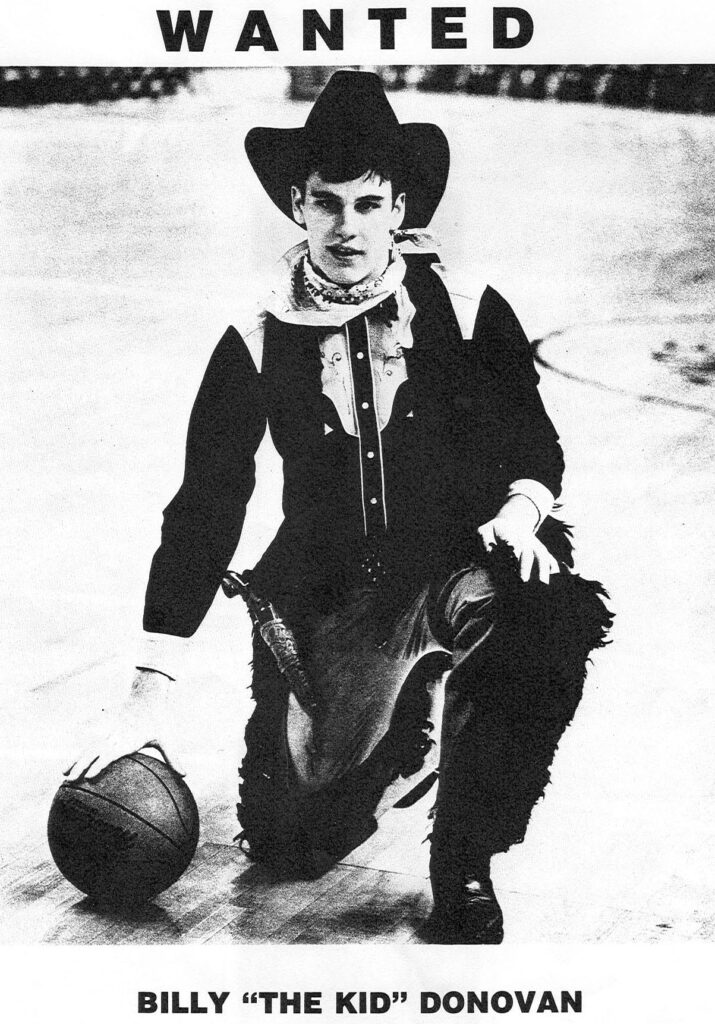
The most notable of course from this group is Donovan, the on-time “Billy the Kid.”
After restoring Marshall to prominence, Donovan did something that seemed virtually impossible: turn a big-time football school like Florida into a basketball mecca.
In 11 seasons on the Gators’ bench, Donovan has compiled a 261-103 record (.706%); guided Florida to two NCAA basketball championships; and coached Florida into nine consecutive NCAA Tournaments.
Because the coaches and players from that 1987 Providence team are scattered all over the country, the 20th anniversary gala may dwarf any college homecoming.
“For me it’s a really big deal,” said Lewis, who resides in Philadelphia. “I haven’t seen some of these guys since ’87 … and Billy and I were roommates. For the college to put on this ceremony is beautiful.”
Sendek, of course, crosses paths with Pitino and Donovan during the course of a season. Not so with the players. But he’s looking forward to renewing acquaintances for a reason other than the obvious.
“I’m sure what I’ll enjoy most is listening to the ‘war stories’ and how they’ve become exaggerated over time,” quipped Sendek. “That’s really going to be something else.”
Just like the ’87 Friars were something else, a team the likes of which hasn’t been seen around Rhode Island (or southeastern New England for that matter) in generations.

